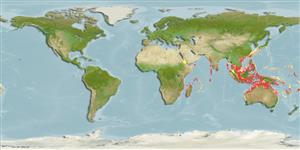Classification / Names
Common names from other countries
Main reference
Size / Weight / Age
Max length : 32.0 cm TL male/unsexed; (Ref. 5213); common length : 27.0 cm TL male/unsexed; (Ref. 43448)
Environment
Marine; reef-associated; depth range 1 - 84 m (Ref. 27370)
Climate / Range
Subtropical, preferred ?; 35°N - 35°S, 32°E - 173°W (Ref. 27370)
Distribution
Indo-West Pacific: Red Sea to the western Pacific where it ranges from southern Japan to New Caledonia, Vanuatu and New South Wales, Australia. Recently recorded from Tonga (Ref. 53797). Not yet recorded from any oceanic island in the western Indian Ocean. Invaded eastern Mediterranean via the Suez Canal.
Countries | FAO areas | Ecosystems | Occurrences | Introductions
Short description
Dorsal
spines
(total): 11;
Dorsal
soft rays
(total): 12-14;
Anal
spines: 4;
Anal
soft rays: 8 - 10. Body with subequal stripes of brownish red and silvery white; spinous dorsal dark red with a large, quadrangular, whitish blotch in middle of each membrane (except the first) forming a median band; dorsal membrane tips white, except posteriorly (Ref. 4201). Five oblique scale rows on cheek; body depth 2.5-2.8 in SL; head length (HL) 2.65-2.85 in SL; short and blunt snout, its length 4.25-4.7 in HL; interorbital width 4.5 in HL; mouth terminal to slightly inferior, maxilla usually extending nearly to or a short distance beyond a vertical through center of eye, upper jaw length 2.5-2.75 in HL; premaxillary groove often ending above anterior edge of orbit; anterior end of nasal bone with a blunt spine; surface or medial edge of nasal bone spineless; nasal fossa usually without spinules on its edge; upper edge of 1st suborbital bone with a slightly retrorse lateral spine a short distance posterior to a vertical at front edge of eye, followed by a ridge of recumbent spinules; preopercular spine usually about 2/3 orbit diameter, 3.2-5.3 in HL; 3rd-5th dorsal spines subequal, longest in adults 1.9-2.3 in HL; 3rd anal spine 1.35-1.6 in HL (Ref. 27370).
IUCN Red List Status (Ref. 115185)
Human uses
Fisheries: minor commercial; aquarium: public aquariums
More information
ReferencesAquacultureAquaculture profileStrainsGeneticsAllele frequenciesHeritabilityDiseasesProcessingMass conversion
Tools
Special reports
Download XML
Internet sources
Estimates of some properties based on models
Phylogenetic diversity index
PD50 = 0.5000 many relatives (e.g. carps) 0.5 - 2.0 few relatives (e.g. lungfishes)
Trophic Level
3.6 ±0.3 se; Based on diet studies.
Resilience
High, minimum population doubling time less than 15 months (Preliminary K or Fecundity.)
Vulnerability
Low vulnerability (24 of 100)
Price category
